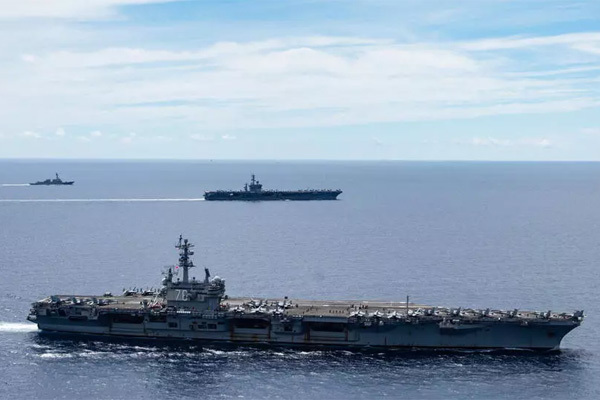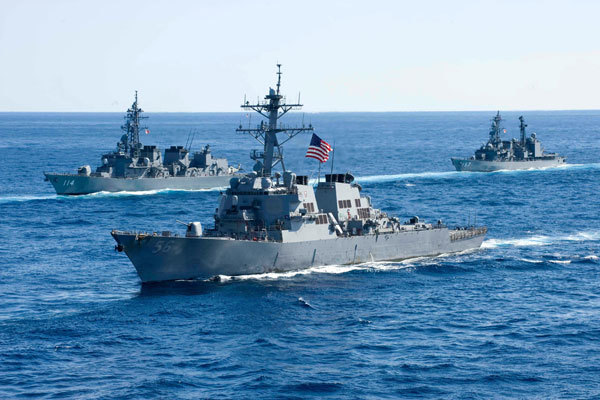The new US administration has launched two consecutive FONOP (freedom of navigation) campaigns passing through Hoang Sa (Paracel Islands) and Truong Sa (Spratly Islands).
After sending the nuclear attack submarine Émeraude and logistics vessel Seine to the East Sea in early March, France will send the amphibious assault helicopter carrier Tonnerre and the destroyer Surcouf to pass through these waters to participate in the first joint naval exercises with the US, UK, Australia and Japan in May in Asia-Pacific.
 |
|
French vessels participate in the exercises with the US and Japan in February. Photo: Japan's Maritime Self-Defense Force
|
The largest newly-launched British aircraft carrier HMS Queen Elizabeth also made her first long trip to this area. Germany has announced plans to send warships to the East Sea in August. Thus, members of the Group of 7 (G7), except Italy, have plans to send warships to the East Sea.
In response, China launched a month-long exercise in March with the participation of two aircraft carriers.
Why has the East Sea attracted such great attention from countries outside the region, including France, the UK, and Germany which have important economic relations with China?
Concern over the Indo-Pacific region
First of all, increasing presence in the region is aimed at protecting freedom of navigation, trade as well as international order based on the law.
This was the move after the three countries of France, the UK and Germany submitted a joint diplomatic note on September 16, 2020 in response to China’s historic rights and Four Sha claims, and the way to draw baselines for offshore archipelagos and extending encroachment on semi-submerged features, which were inconsistent with the UN Convention on the Law of the Sea (UNCLOS) as well as the requirement to respect freedom of navigation and overflight of countries.
The note and the sending of warships to operate free traveling activities in accordance with international law show that these countries care about the Indo-Pacific region, the protection of their economic interests, and cooperation with QUAD countries (Japan, India, Australia and the United States).
France has territories and exclusive economic zones in the Indian and southern Pacific Oceans. The UK has a traditional relationship with Hong Kong, with 12% of maritime trade, over US$130 billion in imports and exports going through the East Sea each year and $80 billion of trade exchange with China (China invests more than $20 billion in the UK).
The UK urgently needs to have stability in the Chinese market and implement the "Great Britain" strategy after Brexit.
 |
|
Aircraft carrier HMS Queen Elizabeth. Photo: Royal Navy
|
Germany has no historical connections but is also looking for a place in this region of considerable importance. These are the factors that promote close security relations between these countries and those in the region.
Second, these countries want to show loyalty and support to the US Indo-Pacific strategy. They want to take advantage of the return in US foreign policy to restore sustainable alliances between the EU, Australia, Japan, and China and expand to India to resolve regional and world issues.
They want US consultation and to enhance their role in political decision-making for this region. For China, this is considered a "follow" of the US in implementing a separate Indo-Pacific strategy.
Third, China also believes that increasing the military presence of other countries destabilizes the region and aims to promote conflict and promote arms sales.
 |
|
Warships of the German navy.
|
Fourth, this activity aims to implement a strategic balancing approach, putting pressure to achieve economic goals, while avoiding increasing tensions with China. Therefore, it can be seen that the operation of warships of these countries will differ from the US in the waters that China have claims. They serve the purposes and interests of these countries themselves.
Due to their limited power and internal problems, these activities are more symbolic, at least in the early stages.
Concern mounts over overheated militarization in East Sea
Countries in the region, dissatisfied with China’s excessive behavior and China's use of power in the East Sea, want to have strategic balancing activities but fear that the East Sea will be militarily overheated, which could cause conflict and local wars. They don't want to be pushed into difficult choices.
Freedom of navigation activities conducted by the US and its allies is one of the ways to demonstrate the validity of international law. These activities by themselves cannot hinder China's ambitions, but along with other activities, they contribute to the internationalization of the East Sea issue. This is not an issue of just China - US relations.
The East Sea needs to be handled on the basis of principles and norms of international law, especially the UNCLOS.
Nguyen Hong Thao

Biden administration outlines strategy to contain China in the East Sea
On February 19, after a month in office, the Biden administration clearly outlined US policy in the Asia-Pacific, especially in the East Sea.

East Sea 2020: The US adjusts its policy, Southeast Asia gets tough with China
Facing China's actions, the United States increased military operations in the East Sea and adjusted its policy towards endorsing the Permanent Court of Arbitration (PCA)'s ruling in 2016.